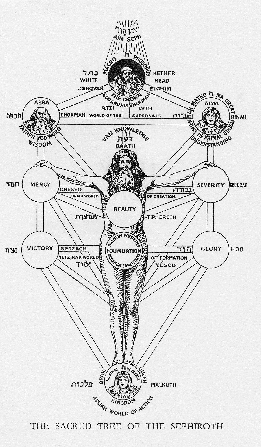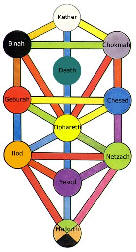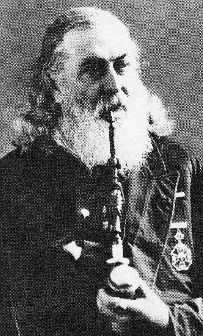The Tree of Life
| By: Carl Teichrib; ©2002 |
| Just as the book of Genesis tells us about the Tree of Life, so too the occult claims knowledge of the “tree of Life’—and offers diverse ways to its fruit. Carl Teichrib explains in this month’s article. |
- Mysticism and occultism abound with symbols that often point to a transcendental reality beyond conscious understanding. —Nevill Drury, Dictionary of Mysticism and the Occult, p. 249.
- Symbolical instruction is recommended by the constant and uniform usage of antiquity; and it has retained its influence throughout all ages, as a system of mysterious communication. —Albert Pike, Morals and Dogmas, p. 372.
We see symbols every day. In the US, the one dollar bill is laced with esoteric markings. Symbols, both Christian and pagan, can be seen in stained glass church windows, cathedrals, and temples. Monuments across the continent act as symbols in and of themselves, and often have other symbols inscribed upon them. Symbols, be they benign or based in occult lore, are inescapable.
A simply way of explaining what symbols are would be thus; symbols are a tangible and visible language conveying a specialized message. In the occult world, those who are trained to “understand” these messages recognize that certain forces are at work in the world—forces which are spiritual in nature. Furthermore, in this world of esoteric learning, symbols hold the key to the secret doctrines and teachings of the ages. These doctrines are steeped in the philosophies of pagan mystery religions and secret societies, forming a spiritual “alternative” to the Biblical worldview; fully equipped with alternative histories, alternative ways of salvation, alternative gods, and alternative realities.
Understanding this greatly amplifies the words of Proverbs 14:12, “There is a way that seems right to a man, but in the end it leads to death.”
Manly P. Hall, one of the most influential occultists of the last century, wrote this of symbols, “They are centers of a mighty force, figures pregnant with an awful power…” (Lectures on Ancient Philosophy, p. 356).
Contents
The Tree of Life:
In the Genesis account of the fall of man, we find God expelling Adam and Eve from the Garden of Eden. Genesis also records that if God had not expelled the couple, they could have eaten from the Tree of Life—whose fruit would bring immortality. If Adam in his sinful state had eaten from the Tree of Life, what would the implications be? An eternally sinful man pitted against an eternally Holy God is the only logical thought that comes to mind. What recourse would God have had other than to completely banish humanity from Himself? Granted, this is only conjecture. However, it is a sobering thought, and it plays into the theme of this article—mankind’s quest to attain the Tree of Life.
Just as the book of Genesis tells us about the Tree of Life, so too the occult claims knowledge of the “Tree of Life”—and offers diverse ways to its fruit. Manly P. Hall, in his monumental work, The Secret Teachings of All Ages, writes, “…the Tree of Life is also the appointed symbol of the Mysteries, and by partaking of its fruit man attains immortality.”
Hall is correct on one account; Yes, the Tree of Life is a central symbol of the mystery religions—those “esoteric” or occult religions and philosophies which have acted as a hidden hand upon society. But does it give man “immortality”? Or is it another version of the same lie as found in the Garden of Eden—“You shall not surely die” (Genesis 3)?
In studying the occult Tree of Life, an obvious irony occurs. While the book of Genesis is God’s Word revealed through the Hebrew people, so too the “esoteric” Tree of Life is likewise linked to an ancient Hebrew text—the Kabbalah.
Until fairly recently, the Kabbalah was virtually unheard of outside scholarly Rabbinic circles and to those deeply involved in esoteric schools. Yet for hundreds of years this “secretive” text has been used as a cornerstone for occult societies and doctrines. Consider the words of Albert Pike—arguably the most influential Freemason that has lived— regarding the importance of the Kabbalah in relationship to the mystery schools and to Freemasonry in particular,
-
- The Kabalah is the key to the occult sciences; and the Gnostics were born of the Kabalists. (Morals and Dogma, p. 626)
- Masonry is a search after Light. That search leads us directly back, as you see, to the Kabalah. In that ancient and little understood medley of absurdity and philosophy, the Initiate will find the source of many doctrines; and may in time come to understand the Hermetic philosophers, the Alchemists, all the Anti-papal Thinkers of the Middle Age, and Emanuel Swedenborg. (Morals and Dogma, p. 741)
- All truly dogmatic religions have issued from the Kabalah, and return to it: everything scientific and grand in the religious dreams of all the illuminati, Jacob Boehme, Swedenborg, Saint-Martin, and others, is borrowed from the Kabalah; all the Masonic associations owe to it their Secrets and Symbols. (Morals and Dogma, p. 744)
- The Hermetic Science of the early Christian ages, cultivated also be Geber, Alfarabius, and others of the Arabs, studied by the Chief of the Templars, and embodied in certain symbols of the higher Degrees of Freemasonry, may be accurately defined as the Kabalah in active realization, or the Magic of Works. (Morals and Dogma, p. 840)Interestingly, the first English translation of the Latin Kabbala was completed by S.L. MacGregor Mathers, an occultist highly involved in Freemasonry and numerous other esoteric schools. Clarifying the Kabbalah’s history, Mathers wrote, “The Qabalah may be defined as being the esoteric Jewish doctrine.” (The Kabbalah Unveiled, p. 2). [Note: Kabbalah is spelled many different ways—with a Q, with a C, and with a K].
But why go into such a lengthy discourse concerning the mystical usage of the Kabbalah? Because in order to understand the occult Tree of Life, one must look at its roots—literally. And the esoteric Tree of Life is found in the secret teachings of the Kabbalah. [Note: Teachings concerning the Tree of Life are not necessarily explicit in the Kabbalah. A.E. Waite, a contemporary of Mathers, explains in his book The Holy Kabbalah that the Tree and its meaning is “implied continually” within the Zohar, one of the major books that make up the Kabbalah.]
Nevill Drury, in his Dictionary of Mysticism and the Occult, offers a simple (?) explanation of what the occult Tree of Life represents in its relationship to the Kabbalah,

- The Tree consists of ten spheres, or sephiroth, through which—according to mystical tradition— the creation of the world came about. The sephiroth are aligned in three columns headed by the supernals and together symbolize the process by which the Infinite Light…becomes manifest in the universe…Taken as a whole, the Tree of Life is also a symbol of the archetypal man Adam Kadmon, and the sephiroth have a role resembling that of the charkas [sic] in yoga.
All of this can become rather confusing, and the study of the Kabbalah itself can become bogged down in terminology foreign to most westerners. Yet the deeper meaning is fairly easy to grasp: The occult Tree of Life is a path in which the initiate—the occult student—discovers and experiences the “inner light” (also called the “inner Christ”). It is a system of spiritual doctrines which opens up the mind and the soul to a new level of understanding— “salvation comes from within.”
The Hermetic Order of the Golden Dawn, one of the most mysterious western occult schools, greatly employed the knowledge of the Kabbalahistic Tree of Life within its rituals and teachings. Israel Regardie, in his massive reference work on the rituals and teachings of the Golden Dawn, tells us that this path is an “exulted condition of consciousness…an essence or spirit which is everywhere and at all times expressed in terms of Light.” (The Golden Dawn: A Complete Course in Practical Ceremonial Magic)

Freemasonry and the Hermetic Order of the Golden Dawn are only two of the many esoteric orders that claim doctrinal ties to the Kabbalah, and the quest for the Tree of Life. Rosicrucian and Theosophical societies—both claiming to be depositories of “secret knowledge”—also introduce their higher initiates to its forbidden fruit. Other historically significant mystical organizations, as earlier mentioned by Pike—Martinists, the followers of Boehme, Swedenborg, and the Knights Templar—have all drawn heavily from the Kabbalah.
The Tree of Life is also known by other names, including the Cosmic Tree and the World Tree. However, both the Cosmic Tree and the World Tree may have other connotations and symbolic meanings—i.e., the Celts regarded the oak as the Cosmic Tree while in Scandinavia it was the ash. And yet, the Tree of Life as understood by students of the Kabbalah holds both of these alternative titles.
A similar concept to the mystical Tree of Life can likewise be found in Buddhism. Jean Chevalier and Alain Gheerbrant tell us in the Penguin Dictionary of Symbols; “The Bodhi-tree under which the Buddha obtained enlightenment is yet another World
Tree and Tree of Life, and in early Buddhist iconography it stands for the Buddha himself.” Other societies around the world have similarly incorporated some form of “Tree of Life” into their mythologies, religions, and mystic philosophies. It’s a global symbol.
The irony in studying the Tree of Life—as stated earlier, is that it has two “Hebrew” branches—one, the Genesis account; the second, the teachings of the Kabbalah. Without straying too far from this article’s purpose, it has to be noted that this is not an indictment of Jews, nor is it in any way an anti-Semitic stance. The fact remains that many cultures have had mystic offshoots that have played influential roles, both historically and in our modern society. The founding of America is one such example; while the US has had a strong Christian heritage, it has an equally strong Masonic-historical foundation. Ironic, yes; however, these contradictions are just the realities of our fallen world.
The bottom line is this: the quest for the mystical Tree of Life is simply the desire to take the Garden of Eden by force, tear down whatever barriers stand in the way of its fruit, and by man’s own hand taste immortality. The result will be catastrophic for the individual who, through the occult and the works of magic, attempts to gain “everlasting life” outside of God’s prescribed way—“the way and the truth and the life”—Jesus Christ.
However, Jesus Christ gave an awesome promise in the book of Revelation concerning the Tree of Life, something that we as believers can hold onto,
- Behold, I am coming soon! My reward is with me, and I will give to everyone according to what he has done. I am the Alpha and the Omega, the First and the Last, the Beginning and the End.
- Blessed are those who wash their robes, that they may have the right to the tree of life and may go through the gates into the city. — Revelation 22:12-14.
P.S. A point of clarification: Esoteric organizations such as Freemasonry are implicit rather than explicit in their use of Kabbalah; that is, while they don’t openly teach from the Kabbalah (most Masons don’t even know what it is), their symbols and esoteric doctrine are steeped in its mystical teachings.
(Carl Teichrib is a researcher and writer on world religions and the impact of globalization on Christianity. You can email him at [email protected].)









[…] Read Part 16 […]
[…] REDIRECT The Tree of Life […]